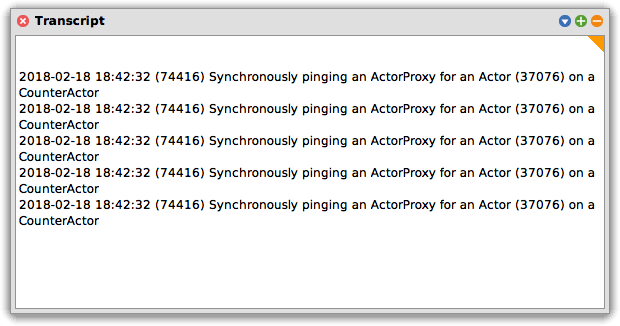Ping-pong
This tutorial introduces different interaction patterns by way of two peers exchanging messages in a back-and-forth, “ping-pong” pattern.
It also touches on linking actors together.
Synchronous version
Our first example will “ping-pong” back and forth between two actors.
The “ping” step will be a request from a PingPong1 to a
CounterActor (from the previous tutorial),
and the eventual reply from the CounterActor to the PingPong1
will be the “pong” step.
Defining our behavior class
We do not need any instance variables for our PingPong1 actor. It is
stateless.
ActorBehavior subclass: #PingPong1
instanceVariableNames: ''
classVariableNames: ''
poolDictionaries: ''
category: 'ActorExamples'
Defining our main method
Invoking increment: aCounterActorProxy times: anInteger causes
anInteger RPC calls to be issued to aCounterActorProxy.
increment: aCounter times: count
count = 0 ifTrue: [^self].
self logAll: 'Synchronously pinging ', aCounter printString.
aCounter increment >>= [ :incrementedValue |
self increment: aCounter times: count - 1 ] bindActor.
Notice use of the >>= operator. Because aCounter is a
proxy, invoking methods on it results in a
promise. The >>= operator on a promise adds a
continuation to it: when the promise is eventually resolved, the
continuation is invoked with the resolved value of the promise. The
call to bindActor on the continuation block ensures that the code
inside it will run in the context of the PingPong1 actor.
It looks like the code is making a recursive call to itself, but this
is not what is happening, and you will not see more than a single
increment:times: context on the PingPong1 actor’s stack at once.
After >>= finishes attaching the continuation block to the promise
returned by increment, the method simply continues executing. Since
it is at the end, it returns self, as usual for Smalltalk.
This means that the original call to increment:times: completes well
before the resulting chain of ping-pong RPC calls has finished. By
attaching a continuation to a promise and allowing the main thread of
execution to continue, the actor returns to responding to new
requests, even while a “background” task is continuing in some other
actor.
Running the example
First, create the two actors that will interact with each other:
actor1 := PingPong1 spawn.
actor2 := CounterActor spawn.
Now, open a Transcript window. Then, start the interaction:
actor1 increment: actor2 times: 5.
You should see output like the following in your Transcript.

Finally, terminate the two actors:
actor1 actor terminate.
actor2 actor terminate.
Asynchronous version
Our second example will be similar to the first, but will use
asynchronous, one-way messages instead of synchronous RPC. The “ping”
and “pong” steps will be symmetrical. Each will be a one-way request
from one PingPong2 actor to another.
Defining our behavior class
Again, our actor is stateless, and needs no instance variables.
ActorBehavior subclass: #PingPong2
instanceVariableNames: ''
classVariableNames: ''
poolDictionaries: ''
category: 'ActorExamples'
Defining our main method
The chief difference between ping:times: here and increment:times:
above is the use of async. A one-way request doesn’t return a
promise, since no reply (or exception) will be forthcoming. Also, a
one-way request is asynchronous, so execution continues on after
sending the next message to peer, and the method completes normally,
freeing the actor up to handle the next incoming request.
ping: peer times: count
count = 0 ifTrue: [^self].
self logAll: 'Asynchronously pinging ', peer printString.
peer async ping: Actor me times: count - 1.
Running the example
First, create the two actors that will interact with each other:
actor1 := PingPong2 spawn.
actor2 := PingPong2 spawn.
Now, open a Transcript window. Then, start the interaction:
actor1 ping: actor2 times: 10.
You should see output like the following in your Transcript.

Finally, terminate the two actors:
actor1 actor kill.
actor2 actor kill.
Linking
We can arrange for our two interacting actors to terminate
together—fate sharing—by
using the Actor >> #link method.
Add the following method to PingPong2:
linkTo: anActorProxy
anActorProxy actor link.
Usually, linking is a private implementation decision of a behavior
object. It is unusual to see outsiders supply actors to link to. The
linkTo: method would be unlikely to exist in a real program.
As explained on the page about
proxies,
every actor has a “proxy” that takes care of the details of
marshalling requests to be sent to it, and every proxy has an
associated actor. The main difference between them is that messages
sent to the proxy are converted into requests and
sent as inter-actor messages to the actor, which will then invoke
them on the actor’s behavior object; whereas
messages sent to the actor, the instance of Actor,
will directly trigger behavior on the Actor object itself.
If you like, the proxy is the “user-level” object that is for everyday use interacting with an actor’s behavior, and its actor is for meta-level or reflective operations on actors, interacting with an actor’s process.
Here, we want to link two processes together, so that when one
terminates, the other does as well, and so we invoke the link method
on an Actor. If we had sent link to the proxy, it would have
looked for a method called link on anActorProxy’s behavior object,
which is unlikely to exist.
Reprise, with links this time
After creating the actors,
actor1 := PingPong2 spawn.
actor2 := PingPong2 spawn.
we link them to each other:
actor1 linkTo: actor2.
Now, if one dies, so does the other.
Open a process browser, and check to see that both actors are there.
Now, kill actor1.
actor1 actor terminate.
Check on the process browser (you may need to refresh it, or turn on auto-updating), and see that neither of the actors remain.
In your workspace, invoking “print it” on actor1 and actor2 will
similarly show that they have both terminated:
actor1. "an ActorProxy for an Actor (24140) on a PingPong2 (terminated)"
actor2. "an ActorProxy for an Actor (10267) on a PingPong2 (terminated)"